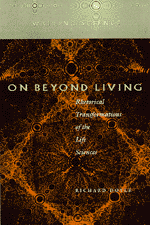

![]()
![]()

The book analyses modern biology's discourses, and attempts to elucidate the 'rhetorical software' that makes this redefinition possible. Doyle studies pivotal texts of Richard Dawkins, Erwin Schrödinger, François Jacob and other scientists that have helped ensure this transformation. Importantly, Doyle does not study the active roles of the scientists, but of their texts. Critiquing textual inquiries that attempt to uncover meanings or to trace significations, he argues for an analysis that foregrounds the way language is performative. Narrative is forceful, Doyle argues: it delineates what can be said and what cannot; it codes experiments even before something is written about them.
Doyle's book is a critical analysis: he wants to point at the 'slippages' in the rhetoric; the jumps, unsaid assumptions, and untold reductions that make possible the workings of the rhetoric in the first place. Doyle's argument is not with the existence of such slippage per se: such back- and foregrounding is at the root of any attempt to create a general understanding of a phenomenon. Rather, Doyle critically questions a systematic feature of the slippage he encounters in the texts studied: the erasure of embodiment, the deletion of context, and the denial of the possibility of multiple interpretations.
So, Doyle analyses a text by George Gamow which discusses how DNA is 'read' and 'translated' into proteins. The metaphors of 'translation' and 'deciphering' that structure this text, Doyle argues, work from a promise of True translation: a complete determination of the organism by the DNA. The metaphor suggests a passive, disappearing reader, and a text which is one with its meaning, and that is fully and unambiguously translatable - like the Scripture. In molecular biology as in postmodernism, language speaks Man, Doyle remarks in one of his many reflexive twists (p. 61). The slippage is evident with this invocation of postmodernism: texts are never one with their meaning - true translation is a chimera, an illusion which deletes the active, interpretative role of the reader. Re-written in this light, the translation of DNA into living matter might resemble not so much Revelation, or a process of encoding a standard message with an espionage code book, but rather the reading and re-reading of a Pynchon novel which never grounds nor closes (p. 63).
Likewise, Doyle analyses the rhetorics of Artificial Life: that brand of computer science that 'simulates' life by developing self-evolving computer programs that exhibit behaviours seemingly characteristic of life - flocking, schooling, reproducing, dying. It aims to develop a more 'general' theory of life; one that is not based on the 'single example' of 'carbon-based life' but that gets to the essence of life that lies beyond this contingent carbon container (pp. 111 - 12). Sharply, Doyle queries just how A- life establishes that its gadgets are seen as meaningful to fundamental biological questions rather than as smart and witty computer games. How does its rhetorics work to frame what a 'general' theory of life should consist of? What criteria do we have to judge its sensibility? The rhetoric operates, amongst others, through equating 'DNA' with 'program', and 'program' with 'life'; it forgets embodiment. It forgets, for example, 'the technological ensemble of discourses and computer that are its food, environment, body, and explication'; it forgets, similarly, the bodies the of A-lifers themselves that are 'enmeshed with the translational practices [that create these] "lively" creatures, translation practices that include their own disavowal' (pp. 128, 132).
It is impossible to do justice to the rich insights that Doyle offers. The book is filled with beautiful insights and sharply drawn analyses. At the same time, in all its eloquence, Doyle's style of writing is sometimes dense and hard to follow. Conclusions are poignantly and powerfully stated - yet in some instances, the force of Doyle's rhetorics works even when the argument that led to the conclusion was thin, seemed to slip, or was difficult to comprehend.
More problematic is Doyle's rather unreflexive handling of the slippages. In a text that so convincingly and reflexively argues for the performative, constructive nature of narratives, it is odd to find that Doyle's own rhetorical demonstration of the slippages rests on a rather commonsensical, non-constructivist invocation of Life-as-it-really-is. Insistently, Doyle argues that a certain metaphor is 'logically impossible' when taken literally (p. 69); repetitively, he makes claims like 'a "program" is not itself sufficient for life' (p. 127). Constantly, then, a rather essentialist image of life seems to unreflexively function as a ground figure against which the absurdity of molecular biologists' rhetorics has to become evident. Doyle ironizes the reductionism of the texts he analyses by invoking a 'truer' image, one that is 'obviously' more accurate. Doyle wants to break the efficient realism of the texts he studies, to argue for the constitutive, forceful nature of language - yet to do so, he paradoxically needs to invoke a similarly realist, unconstructed, prediscursive body to carry his rhetorics.
This is a weakness that strikes at the heart of Doyle's enterprise, since it is exactly the 'obviousness' of the imagery invoked by molecular biology, and the unreflexiveness with which this grounding movement is hidden, that he sets out to critique. Notwithstanding this weakness, this book will be a vital resource for anyone interested in the genetization of Life. It is unparalleled in its analytical detail and depth, and the originality of its insights easily surpasses the majority of books and articles that discuss this topic.
Marc Berg
Maastricht University